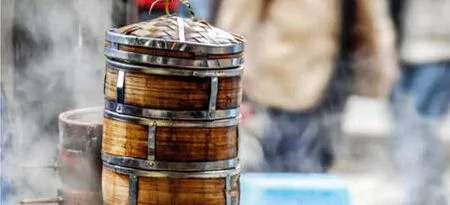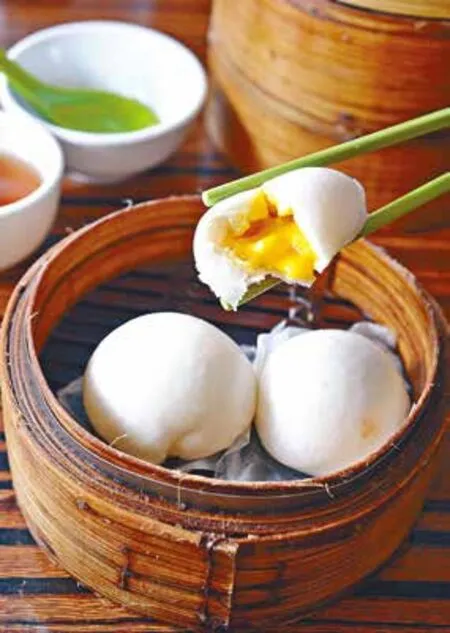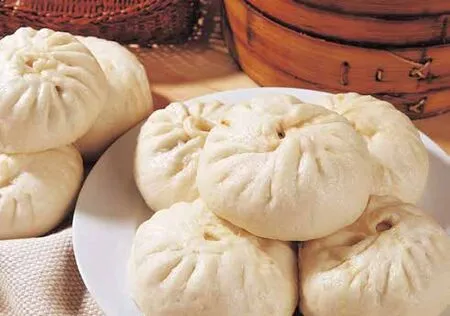STEAM OF RIVALS
STEAM OF RIVALS
In search of the perfect xiaolongbao, Sun Jiahui finds several regions claiming the title
天南地北,“包” 羅萬象

Earlier this year, Time Out London landed itself in the soup for misrepresenting a beloved Chinese snack—xiaolongbao (小籠包, “small steam-basket buns”), characterized by their translucent skin and pipinghot juice, surrounding a rich filling of meat or seafood.
Time Out’s video—classily subtitled“Love popping spots AND eating dumplings?”—was intended to promote a new dim sum restaurant. Instead, it showed diners viciously poking holes in the buns’ delicate skin and letting its delicious soup seep out, along with the tears of Chinese foodlovers around the world.
After thousands of angry tweets, open letters from foodies (“[it’s] the equivalent of smearing jam all over your plate/dining table,” wrote one,“and eating your toast plain”), and even the scorn of the Global Times’Chinese version, the magazine was forced to issue an apology for its scandalous depiction of the “super dribbly…exploding dumplings,”adding, “We’d like to invite the knowledgeable food-lovers of China and Asia to tell us what traditional delicacies we Londoners should try, and how to eat them properly.”

A chef prepares a simple xiaolongbao recipe
They could have just asked a Chinese teacher. The proper way of eating xiaolongbao has long been communicated by short rhyme: “Open a window [in the skin], slurp the soup, swallow the bao, and your mouth is full of flavor” (先開窗,后喝湯,一口吞,滿口香)—essentially, the opposite of Time Out’s method. A perfectly made xiaolongbao is honored with another Chinese saying, “The skin doesn’t break when it’s picked up, the bottom doesn’t fall out when it’s flipped; suck out a mouthful of gravy, the taste is savory but not too rich.”
Achieving this standard of perfection is no mean feat, though the steps themselves are fairly simple: Pork skin is sliced and boiled in water until it forms a thick broth, which is then cooled until it congeals into jelly. The jelly is added to the filling, so that when the buns are steamed, it will melt back into soup.
There are numerous online training courses promising to teach this process in two to three days. It’s rumored, however, that xiaolongbao chefs at the Michelin-starred Din Tai Fung, an international chain of bao restaurants founded in Taiwan, undergo a sixmonth training period. Yang Jihua, the second-generation owner of the chain, told Xinhua News back in 2012 that rigorous standards are the secret to the company’s worldwide acclaim:“Fillings are mixed in a central kitchen kept at 18 degrees [Celsius] for pork or 16 degrees for shrimp.”
The size and weight of the ingredients are also controlled: The filling for each bao must weigh 16 grams, the skin 5 grams. The final product should have 18 creases at the top, weigh 21 grams each, and undergo four minutes in the steaming basket before serving.
Yang told Xinhua he gets calls from entrepreneurs wanting to franchise his restaurant every day, but rejects them all, because “to create a business that will last 100 years, one has to go slow.”
But although Din Tai Fung has been a favorite pick of New York Times food critics since 1993 (when it was the only Asian restaurant on their lists), the brand’s performance on the Chinese mainland is average at best. For most, xiaolongbao is primarily a breakfast food and street snack as opposed to gourmet sit-down fare, and several cities have their own variation, though they don’t all go by the same name.
This has also bred intense competition: The shortlist of those claiming to make China’s best or most authentic xiaolongbao include Shanghai—arguably the best known—Hangzhou, Wuxi, Nanjing, Suzhou, and Changzhou on the Yangtze River Delta, as well as Wuhu and Huizhou in Anhui province and Kaifeng, in Henan.
“殺盡倭寇,強我中華!”“誓與石牌共存亡!”猶如平地起炸雷,第十一師全體官兵在鳳凰山頂發出一陣滾雷般的怒吼。
The town of Nanxiang (南翔), now part of Shanghai’s Jiading district, is one place currently winning this race:“Nanxiang Xiaolong,” which claims to date back to 1871, is a branded trademark whose buns are sold in the frozen aisles of supermarkets all around the country. A restaurant called Nanxiang Xiaolong Mantou, near the City God Temple in Shanghai, has supposedly had locals and tourists lining up for bao almost every morning for over a century.
Nanxiang Xiaolong’s recipe was passed down exclusively from master to apprentice. Li Jiangang, its sixthgeneration inheritor, has been making bao over 40 years. In 2000, Li decided to standardize the method of preparation: wrappers 1.5-millimeter thick, weighing 8 grams; filling of 16 grams in each bao; and the cooked bao should have a diameter of 2.5 centimeters and 18 creases at the top. These guidelines were adopted intoChina’s list of National Intangible Cultural Heritage in 2014.

Visitors at the 2012 Nanxiang Culture Festival enjoy their favorite local snack
Other cities, however, continue to put up a fight. Located on China’s central plains, Kaifeng has little geographic or cultural similarity to the decadent bao heartland of the Yangtze Delta. But compared to the upstart, immigrant-built Shanghai, it has ancient history on its side. Kaifeng’s soup-filled guantangbao (灌湯包) is essentially an enlarged version of the Nanxiang and Din Tai Fung variations and claims to be the ancestor to xiaolongbao; it traces its origin to the Northern Song dynasty (960 – 1127), when Kaifeng, a Yellow River entrep?t, was named the imperial capital. The size of an adult’s fist, guantangbao is characterized by rich, thick soup and soft skin folded to resemble a chrysanthemum—a flat shape and deep, swirly creases.
When the Song were driven south by the Jurchen invaders, eventually setting up a new capital in Hangzhou, the soup bao was allegedly introduced to the Jiangnan (“River South”) region as well. Today, Hangzhou puts up a good showing in the xiaolongbao power rankings, emphasizing that its bao are distinguished by their crab-roe filling and creamy texture, which is caused by the batter being mixed with boiling water.
It’s also one of the likelier varieties you’ll encounter outside the Yangtze region, due to the size of the diaspora from the counties surrounding Hangzhou. Wuxi retorts that its xiaolongbao are richer, bulkier, with a delicate hint of sugar in the filling and a chewy texture. It’s often spoken of in pair with the similar, but sugarless, Changzhou xiaolongbao, which advertises itself with another local saying, “It’s better to wait for the bao than let the bao wait for you”—that is, the diner might have to queue up for the delicious bao, but the delicacy certainly never has to wait for any diners.
What it is about these tiny soup bombs that make emotions run to boiling point? Folk wisdom says it’s due to the name, since the character 籠(“steaming basket”) is a homonym for龍 (“dragon”), the symbol of Chinese civilization. There’s also the theory that cities in the South, in particular, scramble to claim xiaolongbao as their own because it epitomizes the values of Jiangnan cuisine—an outwardly delicate appearance, concealing a riot of complex and decadent flavors. It’s also associated with other Jiangnan cultural elements like tea-drinking or flower-watching, as it’s frequently served as a snack during both activities.
Its popularity is such that the name, xiaolongbao, has become something like a brand. As the more pedantic Jiangnan locals will tell you, its traditional name is simply tangbao (soup bao) or xiaolong mantou, mantou (饅頭) being what northerners call steamed buns with no filling. Purists in Henan also bemoan the gradual replacement of the name guantangbao with “Kaifeng xiaolongbao,” which they feel is pandering to the rest of the country. There are even overseas Chinese restaurateurs who have fabricated a connection between these xiaolongbao and Bruce Lee, whose Chinese name is Li Xiaolong (李小龍), to sell crowdpleasing “Bruce Lee dumplings” and“kung fu dumpling specials.”
While it’s not easy to decide which area has the best xiaolongbao, bizarrely, the title “China’s No. 1 Bao” (中華第一包) goes to none of them. It is claimed by Tianjin’s Goubuli (狗不理, literally, “Dogs Ignore”) restaurant, whose bao are also on the National Intangible Heritage list (the dish has nothing to do with dogs, but refers to the founder of the restaurant,“Puppy”)—now that’s a scandal.

Street vendors in Kaifeng and other cities sometimes sell guantangbao with a straw for the soup


THE ORIGINS
The story of steamed buns (包子, báozi) can purportedly be traced back to the Three Kingdoms era (220 –280), when Zhuge Liang, chancellor of the Shu state, led his army against Nanman (literally “southern barbarian”) forces and took back a load of captives. When a river blocked their route home, a local warlord suggested throwing 49 Nanman heads into the water as a sacrifice. Zhuge apparently balked at this grisly proposal, so ordered his troops to sacrifice some livestock and use the meat to fill some head-sized buns. The river was seemingly becalmed by the offer and buns became a thing—mantou (蠻頭) comes from “蠻”(barbarian) and“頭” (head) During the Song dynasty, baozi or bao came to mean filled buns, while mantou specifically referred to regular buns, with “蠻頭” evolving into the homophone “饅頭.”
Today’s baozi is no longer the size of a decapitated head (and is usually a more appetizing proposition), but instead come in a variety of competing forms, aside from xiaolongbao.
Beijing’s Qingfeng Baozi
北京慶豐包子鋪
Beijing is known for its chain of Qingfeng Baozi, a blue-collar brand with a 60-year history that arguably peaked in 2013, when President Xi Jinping dropped by for a casual visit. Photos of Xi queuing to buy baozi went viral, and Qingfeng quickly introduced the “President Set” meal—six baozi filled with pork and scallions, with stir-fried liver and greens on the side. Things didn’t stop there: The table and chairs where Xi ate were removed and sent to the company headquarters; the Gulou location became an official stop on domestic package tours; and the otherwise shabby chain launched an aggressive expansion plan, including a “steamed bun research center.”
Tianjin’s Goubuli 天津狗不理
The title “China’s No.1 Bao”is claimed by a brand from a neighboring city, Tianjin—Goubuli, which means “dogs ignore.” The baozi that even dogs don’t care about appeared in 1858, although the name actually refers to the nickname of its late Qing dynasty founder Gouzai, or“Puppy,” who insisted he was too busy making bao to speak with customers. Even Empress Dowager Cixi, known for her sophisticated taste, was a fan of Gouzai’s baozi, proclaiming, “The goat running around in the mountains, the wild geese flying between the clouds, the cattle and sheep in the fields, and the rare seafood living in the deep ocean—none are as appetizing as Goubuli. One can live long by eating it.”
Today, Goubuli has 98 varieties of baozi and has left behind its regular roots: a plate of eight buns costs over 200 RMB, earning the restaurant the nickname “LV baozi” (its English name is Go Believe). The changes have apparently turned off locals.“We don’t eat Goubuli anymore. They just exist to earn money from tourists,” says Tianjin native Tang Yajun, 35. “When my generation was young, Goubuli baozi were still something ordinary families could afford. But today, no one goes there except out of nostalgia.”


Clockwise from top left: cha siu bao; steamer basket for cooking bao; baked bao; regular steamed bao; panfried shengjianbao;and liushabao


Shanghai’s Pan-fried Baozi and Xinjiang’s Baked Baozi
上海生煎包和新疆烤包子
If there’s one thing all these bao have in common, it’s steam. That’s not the case in Xinjiang, where baozi is baked until it turns brown and crispy. And in eastern areas like Shanghai, there are also panfried baozi, called shengjian (生煎,“raw pan-fried,”) or shengjianbao, which have a thick, crunchy, slightly oily base. During cooking, water is sprayed on the buns to ensure that the top, which is not supposed to touch the pan or the oil, remains soft.
Cha Siu Bao 叉燒包
In Cantonese-speaking regions, bao is represented by a popular kind of dim sum, cha siu bao: Snowy white, cracked open at the top, and filled with barbecued pork (cha siu). Though they might look similar to steamed baozi, the dough of cha siu bao use both yeast and baking powder as leavening, giving the dough a soft yet firm texture.
Liushabao 流沙包
Sweet tooths may enjoy liushabao, or“quicksand bao,” another Cantonese snake made with salted egg yolk, wheat starch, butter, and milk. The hot custard runs out of the fluffy wrapper like quicksand on first bite—so don’t risk jabbing it with a chopstick like a certain lifestyle magazine encourages.
Baozza 包薩
Chinese and foreign media, including People’s Daily Online and the AP, went wild for this American-designed, Italian-inspired concoction, when it debuted earlier this year at food fairs and pop-up restaurants. Fed up with the dodgy fillings and stodgy dough that are the mainstay of many baozi, two Americans hired a baozi master to fill a light, fluffy, slightly herbed bun with a variety of pizza-like ingredients (pepperoni, tomato, cheese, jalapenos), creating a hybrid gourmet “baozza”that seemed to delight international foodies as much as annoy traditionalists. When TWOC offered a sample to one local vendor, he vehemently insisted that most Chinese would hate the cheese filling, and prefer his best-selling mushroom variety—but the brand’s growing popularity suggests otherwise.

